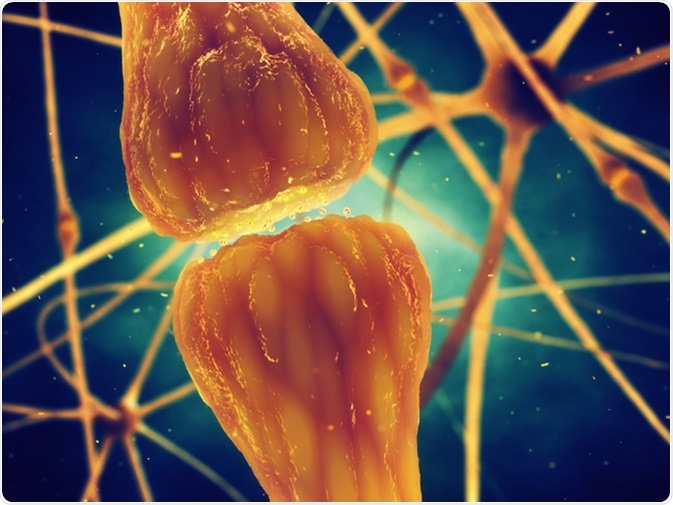Skip to:
Also referred to as chemical messengers, neurotransmitters are chemical agents made and released by neurons. They are stored in vesicles at the terminal end (presynaptic terminal) of a neuron. Their release stimulates nearby neurons, muscle cells or gland cells, thereby allowing electric nerve impulses to be passed from one cell to another.
The presynaptic terminal is separated from the cell; the neurotransmitter stimulates by a small gap called the synaptic cleft. Together, the presynaptic terminal, synaptic cleft and the receiving dendrite of a nearby nerve cell form a neuronal junction, also called a synapse. The synapse between a nerve and muscle cell is referred to as a neuromuscular junction.

Synaptic transmission is the biological process by which neurotransmitters are released by a neuron and activate the receptors of another neuron. Image Credit: Nobeastsofierce / Shutterstock
How does neurotransmitter signaling occur?
When an electrical impulse reaches the presynaptic terminal of a nerve cell, the vesicles move through the cytoplasm and form a connection with the presynaptic terminal membrane and release neurotransmitters that move through the membrane into the synaptic cleft. They migrate across the synaptic cleft to the postsynaptic membrane of the neighboring nerve cell and bind to receptors on that membrane, which activates them to either open or close ion channels in the membrane.
Activation of ion channels changes the cell's permeability, which either triggers depolarization or hyperpolarization. In the case of depolarization, the cell generates an action potential that starts an electrical impulse. In the case of hyperpolarization, the cell does not generate an action potential and an impulse is not initiated. A neurotransmitter that triggers an action potential in the receiving neuron is referred to as an excitatory transmitter, while one that prevents an action potential is called an inhibitory transmitter.
The third type of neurotransmitter - neuromodulators - work differently; they are not confined to the synaptic cleft between just two nerve cells but can regulate many neurons simultaneously.
All neurotransmitters can bind to several different types of receptors and are therefore functionally versatile.
Neurotransmitter categorization
Scientists have discovered many types of neurotransmitters, which are categorized based on their chemical and molecular properties. A neurotransmitter may be an amino acid, a monoamine, a peptide, a purine or a gaseous substance, but the majority are monoamines, amino acids, or peptides. Endogenous substances called trace amines, which are chemically related to monoamines can also serve as neurotransmitters.
Examples of the different types of neurotransmitters include the amino acids glutamate and glycine; the monoamines dopamine and norepinephrine, the neuropeptides somatostatin and opioids, the purine adenosine triphosphate (ATP), the gas nitric oxide and the trace amine tryptamine.
Key neurotransmitters
Acetylcholine
The first neurotransmitter to be discovered was acetylcholine, which is the main transmitter throughout the parasympathetic nervous system. Acetylcholine regulates heart rate, muscle contraction and the dilation of blood vessels. It is also a key neurotransmitter in the central nervous system, where it is involved in maintaining cognitive function.
Glutamate and GABA
The main excitatory transmitter in the central nervous system is the amino acid glutamate, which plays an important role in learning and memory. The main inhibitory transmitter is gamma-aminobutyric (GABA) – a derivative of glutamate. GABA regulates the inhibitory-excitatory balance that is needed to maintain normal brain function.
Glycine
Another major inhibitory transmitter in the central nervous system is glycine. In many of the neurons in the spinal cord and brainstem, glycine co-exists with GABA. Glycine exerts the fast postsynaptic inhibition that is needed to regulate the excitability of neurons. It plays an essential role in controlling auditory processing, pain transmission, metabolism, and many other processes.
Dopamine
The monoamine dopamine is an important neuromodulator involved in many brain functions, with dopamine pathways regulating motor control, motivation, reward and activities such as walking and talking.
Noradrenaline
Also called norepinephrine, the monoamine noradrenaline is the main neurotransmitter throughout the sympathetic nervous system where it exerts its effects on various organs to regulate several functions. It increases the force of skeletal muscle contractions and increases both the rate and force of heart contractions. Norepinephrine activity is essential to the fight-or-flight response, where the body gets ready to respond to or avoid a threat.
Serotonin
The monoamine serotonin is a widely distributed inhibitory neurotransmitter in the central nervous system that is involved in regulating a variety of physiological functions including gastrointestinal function, motility, memory, sleep, mood, and reward processing. Serotonin is involved in a wide range of pathways, including body-weight regulation, aggression, suicidality, anxiety, depression, alcoholism, and obsessive-compulsive disorder.
Histamine
The monoamine histamine is an excitatory neurotransmitter in the central nervous system involved in the regulation of metabolism, temperature, hormones and the sleep-wake cycle.
The Human Brain Science Discovery Documentary HD
Further Reading
Last Updated: Feb 12, 2020